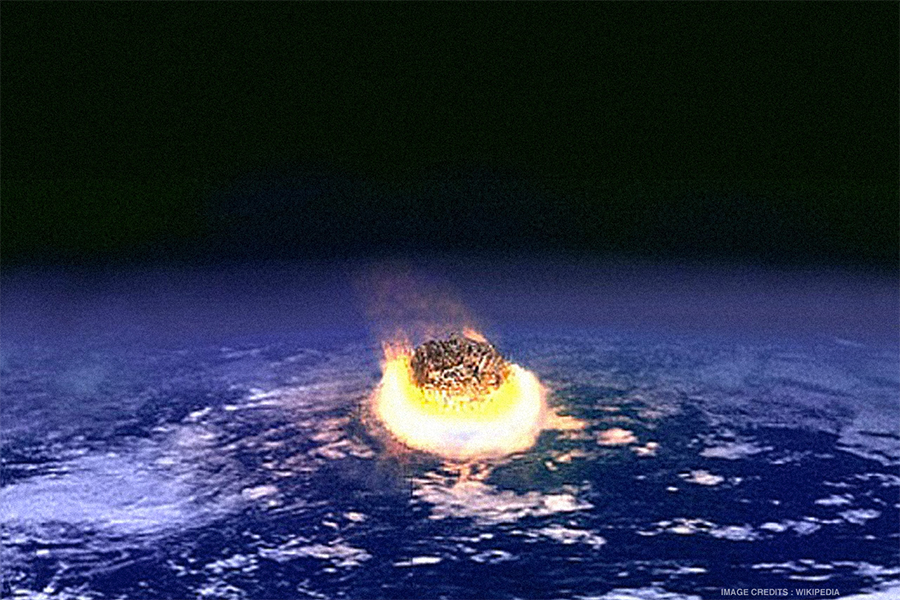What did in the dinosaurs? That giant asteroid (or comet) had accomplices.
The demise of the dinosaurs, some 66 million years ago, represents the ultimate "Cold Case" – no eye witnesses, ancient physical evidence that's partial at best, and a pod of PIs bent on solving the mystery.
Armed with data from an additional decade of fossil discoveries – a new species is unearthed about once a week – and new analytical tools, an international team of paleontologists is pointing the finger at a now-familiar suspect: an asteroid or comet, which triggered the geologically sudden disappearance of dinosaurs.
But, the researchers add, the impactor had accomplices: changing climate and sea levels and a series of eruptions in which magma flooded the surface of a nascent Indian subcontinent as the motion of crustal plates carried it north across the Indian Ocean toward its eventual collision with Eurasia.
"It's bit of a more nuanced story that's coming together," says Stephen Brusatte, a paleontologist at the University of Edinburgh in Scotland and the lead author of a study making the case in the journal Biological Reviews.
The asteroid didn't deliver the coups de grace to a group of animals undergoing long-term decline, he explains, it merely arrived "just at the worst possible time."
Dinosaurs first appear in the fossil record between 245 and 230 million years ago. Today's birds are widely held to be the direct descendants of small therapod dinosaurs known as maniraptors. The hammer fell, however, on non-avian dinosaurs, ending their 160-million-year dominance.
The new analysis draws largely on fossil beds in New Mexico, Montana, and Alberta where sediment layers have preserved a nearly continuous accounting of the dinosaur species alive during the final 1 million years before the impact of the asteroid or comet, which slammed into the end of what is now the Yucatan Peninsula to form Chicxulub Crater. It also draws on fossils from Asia, Europe, India, Madagascar, and South America.
The team notes that dinosaurs vanished as part of a larger mass extinction that wiped out some 75 percent of all species. Small pockets of dinosaurs persisted for a while. But they ultimately yielded the field to mammals and other groups of animals.
Several ideas have been offered as the trigger for dinosaurs' extinction, not the least of which a collision between Earth and an impactor about 6 miles across. One of its attractions is that it neatly explains why non-avian dinosaurs would vanish in the blink of an eye on geological times scales.
Others have argued that dinosaurs had been exposed to increasing stress over many millions of years from climate change, changing sea levels, and repeated eruptions that formed India's Deccan Traps. In essence, these stresses would have led to a long, slow decline in dinosaur diversity. Under this scenario, the impactor delivered the final blow to a population already in decline.
Yet the team's new analysis of the fossil record suggests that with one exception, dinosaurs as a group retained their remarkable diversity to the bitter end. The exception involves plant eaters, mainly large-bodied browsers in North America. The decline in diversity among these animals could well have allowed extinctions among them to snowball once the extinctions began. That, in turn, could have led to a decline in the meat-eaters that preyed on them. The change would have had an effect similar to losing deer or gazelle – large grazers who serve as meals for top predators.
Others have argued for a larger, and perhaps decisive role in the overall mass extinction event for eruptions from the Deccan Traps, which occurred in three pulses. The second pulse, which accounted for some 80 percent of the flows of all three pulses and ended at about the time of the impact, according to research conducted by Princeton University paleontologist Gerta Keller. She and her colleagues also have found geological evidence suggesting that at the time of the eruptions, several meteors smacked Earth. And marine organisms the researchers found trapped in sediments associated with the Deccan Traps point to an environment that Deccan eruptions rendered inhospitable.
Dr. Brusatte readily acknowledges the complexities in trying to sort out immediate and contributing causes that spelled doom for dinosaurs. The team notes, for instance, that the fossil record is too coarse in time to tease out the effects of volcanic activity during the last 400,000 years of the Age of Dinosaurs.
Even so, the team suggests that "volcanic-induced environmental changes may have affected dinosaur communities in other ways during this time, such as changes in population structure or community ecology, or at regional scales that are currently undetectable in the fossil record."
"There was a huge extinction and a huge asteroid, but there's all this other stuff that was happening too and at roughly the same time," Brusatte says. It's possible that some organisms were more vulnerable to the effects of volcanism while others, such as the dinosaurs, were more susceptible to the global effects of the asteroid impact.
But based on the fossil record in North America, no species vanished during that final 400,000 years.
"If that asteroid had never hit and the volcanism had continued, I think dinosaurs probably would have made it," he says. "With dinosaurs, we're pretty confident at this stage that the asteroid is the big reason" that thunder lizards no longer roam Earth.






